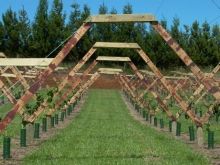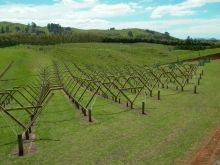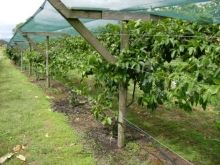Passionfruit Growing Structures
Being rampant climbers, passionfruit need substantial structures to support the heavy crop loading. The three main trellis structures used by New Zealand's commercial growers are "A" frames, pergola and fence. Many growers have adapted and modified these structures to suit their individual needs.
"A" Frames
 As the name suggests, these are fabricated in the shape of an "A" and usually made from timber, but steel can also be used. They need to be strong to support the heavy loading of foliage and fruit.
As the name suggests, these are fabricated in the shape of an "A" and usually made from timber, but steel can also be used. They need to be strong to support the heavy loading of foliage and fruit.
If using timber, 100mm x 50mm is recommended. The "A" frames are attached to posts 150mm (minimum) in diameter and 1 metre long with 500mm above ground. Row spacings vary, depending on the machinery being used but about 3.5m is recommended.
The short posts are driven into the ground about 6m apart in the row and the "A" frames are attached to these. At each end of the rows, about 2m from the last frame, a 'deadman' is driven to attach the wires (a deadman is a substantial post at least 1.8m long with a small end diameter (SED) of 150mm, driven with 500mm above ground). A galvanised screw anchor can also be used.
Four 12-guage wires are strung each side of the frames and the framework of the vines will be trained to these. The top wire is usually about 2m high for ease of vine handling and each subsequent wire is about 500mm apart. It is important to tie back each end frame to prevent it from collapsing inwards
Advantages

- Fruit only needs picking up once a day
- Reduces the cost of mowing and weeding
- Gives 50 percent more canopy area
- Gives better protection from sunburn
- Fruit gets good spray coverage
- Gives better wind protection
Disadvantages
- More costly to erect both in labour and materials
- Foliage can get very dense in between the A frames
- More training/pruning required to keep gap at top open for sunlight penetration
"Y" Frames
 As the name suggests, these are fabricated in the shape of an "A" and usually made from timber, but steel can also be used.Constructed similar to "A" frames, refer above.
As the name suggests, these are fabricated in the shape of an "A" and usually made from timber, but steel can also be used.Constructed similar to "A" frames, refer above.
The frames are braced between each upright arm which leaves a totally open area between the rows.
This aids the movement of warm air and sunlight and enables spraying to be done by overhead boom to spray downwards to achieve better penetration. Frame bracing can be attached to taller upright row posts, if required.
Pergola
A pergola system consists of 2.4m posts being driven to 2m above ground in rows 4m-5m apart. The posts are 6m apart down these rows. Laminated 100mm x 25mm timber is attached across the rows to the top of the posts and steel can also be used.
A deadman is driven at the end of each row to attach the wires (see A frames) and a screw anchor can also be used. A 12-guage wire is run along the tops of the posts, attached with a staple and fastened off each end to the deadman.
Wires are spaced about 500mm apart across the block and each end pergola has to be tied back to the deadman to stop it collapsing inwards. Some variations of this system are used by some growers to increase cropping area.
Advantages
- Gives good protection from both sunburn and wind
- Fruit needs to be picked up only once a day
- Fruit gets good spray coverage
- Mowing and weeding costs reduced
- Disused kiwifruit structures can be used
Disadvantages
- More costly to erect
- A strict pruning regime required to keep gap at top open for sunlight penetration
Fence
 Originally, most commercial passionfruit were grown on the fence system but now this has largely been superseded by the other two systems. A fence is a row of 2.4m posts driven to 2m above ground. Posts are 6m apart down the row and at the end of each row is a deadman or screw anchor (see A frames) for the attachment of wires.
Originally, most commercial passionfruit were grown on the fence system but now this has largely been superseded by the other two systems. A fence is a row of 2.4m posts driven to 2m above ground. Posts are 6m apart down the row and at the end of each row is a deadman or screw anchor (see A frames) for the attachment of wires.
Rows can be 2m - 3m apart depending on the machinery being used. A 12-guage wire is attached at the top of the post and two more wires are run about 700mm apart down the post. There are many variations to this fence system.
Advantages
- Cheaper to erect
- Winter pruning may be quicker
Disadvantages
- Fruit is more exposed to climatic adversities such as wind and hail
- Harder to get good spray coverage on the fruit
- More mowing and weed control required
- Sunburn on fallen fruit more of a problem, fruit needs to be continually collected on sunny days.
- Fruit quality generally inferior to other systems